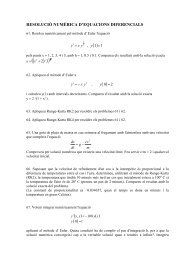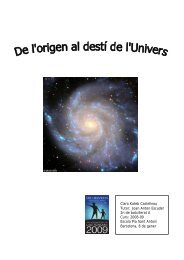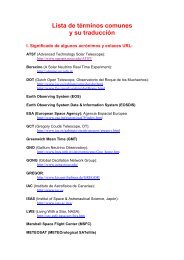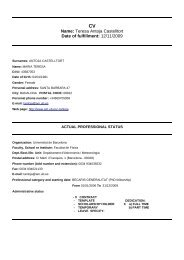Universitat de - Departament d'Astronomia i Meteorologia ...
Universitat de - Departament d'Astronomia i Meteorologia ...
Universitat de - Departament d'Astronomia i Meteorologia ...
Create successful ePaper yourself
Turn your PDF publications into a flip-book with our unique Google optimized e-Paper software.
1.2. Microquasars 21<br />
1.2.4 Accretion disk and jet formation<br />
It is currently accepted that the formation of relativistic radio jets requires the<br />
presence of a compact object (a potential well) and an accretion disk surrounding<br />
it. The mechanism of jet formation and collimation is not yet well un<strong>de</strong>rstood,<br />
but we can gain knowledge and test proposed mo<strong>de</strong>ls after performing observations<br />
like the ones of GRS 1915+105 shown in Fig. 1.7. We can see that after a large-<br />
amplitu<strong>de</strong> quasi-periodic oscillation, the X-ray flux drops substantially, a behavior<br />
interpreted as the emptying of the inner accretion disk. At the same time, the X-<br />
ray spectrum becomes significantly hard, until when an X-ray spike is seen. Then<br />
the X-ray spectrum softens again and we can see the starting of a flare at infrared<br />
wavelengths, which is interpreted in terms of synchrotron emission by an expanding<br />
plasma cloud, as shown above the lightcurves, ejected just when the X-ray spike<br />
took place. As the plasma cloud expands adiabatically, the maximum of the emitted<br />
energy shifts to longer wavelengths, and a subsequent flare is <strong>de</strong>tected in the radio.<br />
Luminosity [arbitrary units]<br />
1.0<br />
0.5<br />
0.0<br />
X−RAYS<br />
Disk<br />
emptying<br />
280.000 <br />
<br />
<br />
INFRARED<br />
Ejection<br />
RADIO<br />
km/s<br />
7.9 8.0 8.1 8.2 8.3 8.4 8.5 8.6 8.7 8.8 8.9<br />
UT Time [hours]<br />
Figure 1.7: Simultaneous multiwavelength behavior at X-ray, radio and infrared wave-<br />
lengths of GRS 1915+105 during 1997 September 9 (from Mirabel et al. 1998).






